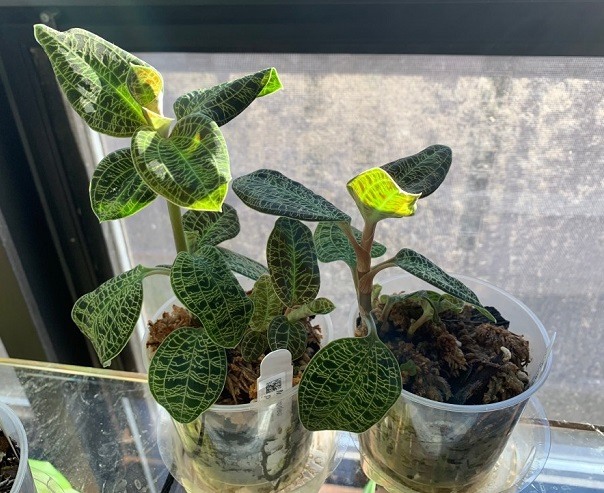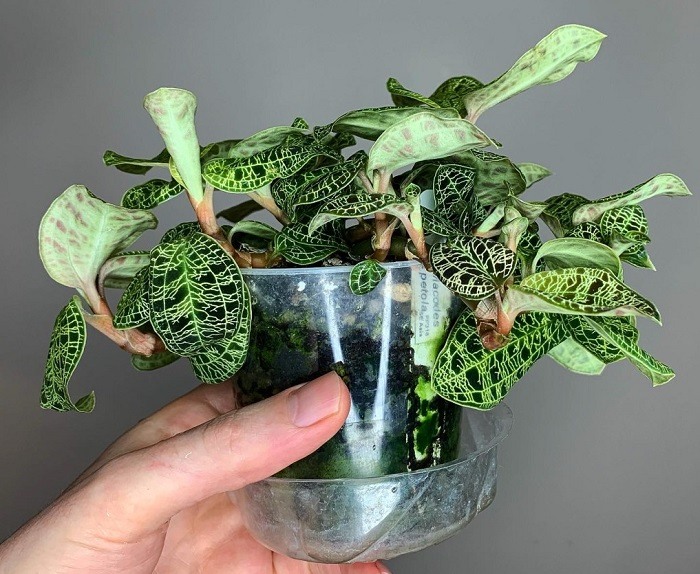Macodes petola is a jewel orchid with vibrant leaves that creates lasting impressions in any interior space regardless of its décor. Caring for this houseplant can be challenging for both season growers and beginners.
Macodes petola care involves the provision of bright indirect sunlight, warm temperatures of about 65-85oF (18-29oC), well-draining soil with relative moisture, and high humidity. I also recommend feeding the houseplant lightly during spring and summer.
The information in this article highlights everything about macodes petola care to enhance successful growth at home. Jewel orchid care is a no-brainer task regardless of an individual experience. Let’s find that out together now.
You May Also Like: Golden Pothos Vs Hawaiian Pothos

What Do Macodes Petola Look Like?
Macodes petola is a stunning foliage plant. Thanks to its crystalline and sparkly veins on the leaves, that look-like gold fleck of a lightning bolt.
This jewel orchid is a tropical stunner hailing from the Southeast Asia rainforest. Macodes petola is the only jewel orchid that grows on the ground rather than epiphytically.
Macodes petola can tolerate indoor growing conditions at home without becoming fussy. But most season grower needs to offer the ultimate jewel orchid care routine.
The terrarium is the best location for growing your jewel orchid. Ensure the macodes petola terrarium has high humidity and warm temperatures.
Besides that, the small stature and low light requirements make this houseplant ideal for the terrarium. The striking foliages help to create a tropical feeling at home.
Research shows that the terrarium keeps the soil moist without getting soggy. It also makes the watering look easier and keeps the leaves dry.
Macodes petola is a non-toxic houseplant to humans and pets. I recommend keeping your houseplant away from children and pets. (Check Best Macodes Petola Price on Amazon).
Macodes Petola Care Details
| Origin | Southeast Asia |
| Scientific Name | Macodes petola |
| Common Name | Lightning Bolt Jewel Orchid |
| Plant Type | Foliage |
| Light Requirements | Bright indirect sunlight. Direct sunlight exposure will scorch the leaves. |
| Watering Needs | Keep the soil consistently moist without getting soggy. Do not wet the leaves when watering. |
| Soil Requirements | Fertile and well-draining potting mix. I recommend a mixture of peat moss, coconut coir, and perlite. |
| Temperature Requirement | 65-85oF (18-29oC). It can also thrive under 60oF (16oC). |
| Fertilizer Application | Feed the houseplant every four weeks during spring and summer. Use a water-soluble fertilizer with low concentration. |
| Humidity Requirements | 50-70% humidity levels. High humidity helps to keep the plant happy and healthy. |
| Flowering | White flowers with chocolate or pale green centers. These flowers are unimpressive and I recommend pruning them. |
| Pruning and Maintenance | Remove old or damaged foliages to maintain compact size and appearance. |
| Propagation | Rhizome division, stem cuttings, and offsets. It takes time and patience to propagate the plant. |
| Re-potting | Minimal re-potting routines. Only re-pot in case of root-bound issue. |
| Pests and Diseases | Pests: Spider Mites, Aphids, Scales, and Thrips. Diseases: Root rot and Leaf spots |
| Toxicity | Non-toxic to pets and humans. |
How to Care for Macodes Petola (Jewel Orchid)
Macodes Petola Soil Requirements
The lighting bold jewel orchid thrives in fertile and well-draining soil. The potting soil should either be neutral or slightly acidic for the houseplant to flourish.
I recommend a mixture of peat moss, coco coir, and perlite. The peat moss helps retain moisture around the roots, and perlite promotes appropriate drainage or aeration.
Add compost to the potting soil to promote fertility. It also helps to replicate its natural habitat in the terrarium. Consider is African Violet Base Mixture. (Check Best Deals on Amazon).
Macodes Petola Light Requirements
Sunlight is an essential macodes petola jewel orchid care. The natural light allows the houseplant to undertake its physiological activities to enhance healthy growth.
Macodes petola does best in bright indirect sunlight. Leaf scorching and drooping effect are due to direct sunlight exposure for an extended period.
The low-light condition will cause leggy stems and stunted growth. Use LED grow lights (Check Best Deals on Amazon) if you need to supplement the natural light.
Jewel Orchid Watering Needs
Macodes petola loves slightly moist soil that never gets soggy. The consistent soil moisture around the roots enhances better growth and plant hydration.
A damp environment increases the risk of root rot due to insufficient oxygen supply. Besides that, dry soil will cause plant dehydration.
The golden rule is to inspect the soil moisture content before watering your houseplant. Insert the index finger in the soil and water the plant if the 2-3 inches of topsoil is dry.
Macodes petola needs more water during spring and summer. Remember to reduce the watering frequency in fall and winter. Be sure to use distilled water or rainwater.
Humidity Requirements for Macodes Petola
Macodes petola prefers high humidity to stay happy throughout the year. Maintain the indoor humidity around 50-70% with proper ventilation.
A humidity level above 80% increases the risk of mold and fungus growth. These pathogens will harm and ruin the appearance of your houseplant.
High humidity reduces water loss via leaves and watering frequency. The high humidity requirement is the reason behind its thriving in terrariums.
Low indoor humidity will result in brown leaf tips and edges. Do not mist the leaves to boost humidity since the plant is vulnerable to leaf spot disease.
Best Temperature Range for Macodes Petola
Macodes petola thrives in shady spaces along with high temperatures. The mold recipe is an odd combination demand for tropical plants.
The jewel orchid does best under a temperature range of 65-85oF (18-29oC). If your tropical plant is experiencing slow growth, consider increasing the temperature.
Consider cooling the houseplant a little bit by maintaining a temperature of 60oF (16oC). But the macodes petola is not tolerant to frost temperatures.
Fertilizing Macodes Petola
Macodes petola is a slow-growing tropical plant that needs less fertilizer. But fertilizer nutrients help to support vegetative growth during the warm season.
I recommend water-soluble fertilizer to feed macodes petola every four weeks during spring and summer. I prefer orchid-specific fertilizer rich in phosphorous.
Organic fertilizer is the best option since there is no risk of overdose. It would be best to read my article on How to Make Homemade Fertilizer for Houseplants.
Macodes Petola Bloom
Many people think that a plant like macodes petola with stunning leaves tends to develop outstanding flowers. But that’s not the case here.
Macodes petole produces tiny and sparse flowers with chocolate or pale green centers. These flowers appear along with the stem spike and can reach 10-inches high during late fall.
These unimpressive flowers are not worth keeping. They make the entire plant leggy and loose after flowering. I recommend cutting these flowers to conserve energy.
Pruning and Maintenance
This lightning bolt jewel orchid needs minimal pruning and maintenance. You’ll need to remove the dead or damaged old leaves to improve the general appearance.
Trimming the houseplant helps to maintain a compact design in the terrarium. Long and leggy stems are vulnerable to breaking. Be sure to use a sterilized hand pruner.
Re-potting Macodes Petola
Macodes petola is less sensitive to transplant. But the task shouldn’t be done more often since the plant takes a long period to acclimate to the new environment.
I recommend macodes petola transplant in case of root rot and root-bound issues. Exercise ultimate care when re-potting the houseplant.
Below are steps for re-potting macodes petola:
Remove the plant from its pot and inspect the roots. Trim the infected portion of the roots with a sterilized hand pruner.
Use a slightly bigger container to give the rhizome adequate space. Fill it with a well-draining potting soil about a quarter.
Place the rhizome in the new pot and fill it up to three quarters with potting mix. Water and provide other essential care regimes to enhance its growth.
Macodes Petola Propagation
Macodes petola propagation is an asexual reproduction. New plants will genetically be identical to their parents. Stem cuttings, rhizome division, and offsets are the most reliable methods.
Remove the macodes petola from the pot for easy offset division. Ensure the offsets have roots before separating them from their parent rhizome.
Stem cutting is another excellent option to consider. Plant the stem cuts in fresh potting mix and water until roots develop.
You May Also Enjoy: How to Grow and Care for Nerve Plants
Common Problems and Solutions
Pests
Macodes petola is susceptible to common pests. Spider mites, aphids, scales, and mealybugs are the leading insects that attack this tropical plant.
Use insecticidal soap spray to eradicate these sap-sucking insects from the houseplant. Be sure to isolate the plant from others to avoid the spread of pests.
Diseases
Excess soil moisture is the leading cause of fungal problems to macodes petola orchid. A damp environment causes root rot and increases the risk of pest infestations.
Prevention is the best policy than treatment. It would be best to detect the fungal problems and rot early to save the houseplant.
Use a fungicide to treat your favorite jewel orchid and provide ultimate care in the long run. Treatment is usually the last resort, and it does not guarantee a healthy plant after all.

Frequently Asked Questions
Why Are My Macodes Petola Leaves Curling?
An inappropriate watering routine, low humidity, and drafts are the reasons behind the macodes petola leaves curling. The best solution is to identify the exact cause and fix it.
Is Macodes Petola Rare?
Yes. This houseplant with beautiful foliages is rare in many plant stores across the United States and Canada. It has low maintenance requirements when compared to other plants.
Is Macodes Petola Toxic?
No. Macodes petola is non-toxic to humans and pets. But I recommend keeping your favorite houseplant away from kids and pets to avoid destruction.
Should I Mist My Macodes Petola?
No. macodes petola leaves are vulnerable to bacterial and fungal diseases. I prefer keeping the leaves dry when watering. Use a humidifier to boost indoor humidity level than misting leaves.
You May Also Enjoy: How to Care for Dendrobium Nobile Orchid
Conclusion
Macodes petola is a valuable and rare jewel orchid species. Growing and maintaining macodes petola is a no-brainer task.
Tissue culture makes macodes petole readily available in the United States. It is the reason behind the appreciation by many Americans and Canadians.
I hope this information will help you grow and maintain your jewel orchid species without facing any challenges. Use the comment section to share your experience.
